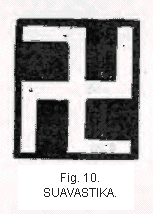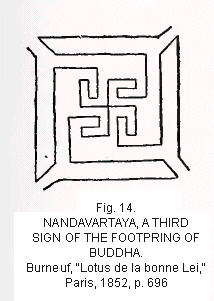

The Swastika
Definitions, Description & Origin
The name Svastika, however, can be traced (in India) a little farther back. It occurs as the name of a particular sign in the old grammar of Panani, about a century earlier. Certain compounds are mentioned there in which the last word is karna "ear.: * * * One of the signs for marking cattle was the Svastika [fig. 41],
 and
what Panani teaches in his grammar is that when the compound is formed,
sraxtika-karna, i.e., "having the ear marked with the sign
of a Svastika," the final a of Svastika is not to be lengthened,
while it is lengthened in other compounds, such as satra-karma, i.e.,
"having the ear marked with the sign of a sickle."
and
what Panani teaches in his grammar is that when the compound is formed,
sraxtika-karna, i.e., "having the ear marked with the sign
of a Svastika," the final a of Svastika is not to be lengthened,
while it is lengthened in other compounds, such as satra-karma, i.e.,
"having the ear marked with the sign of a sickle."D'Alviella (2) reinforces Max Müller's statement that Panini lived during the middle of the fourth century, B.C. Thus it is shown that the word Swastika had been in use at that early period long enough to form an integral part of the Sanskrit language and that it was employed to illustrate the particular sounds of the letter and its grammar.
Max Müller continues his explanation: (3)
It [the Swastika] occurs often at the beginning of the Buddhist inscriptions, on Buddhist coins, and in Buddhist manuscripts. Historically, the Svastika is first attested on a coin of Krananda, to be the same kind as Xandrames, the predecessor of Sandrokyptos, whose reign came to an end in 315 B.C. (See Thomas on the Identity of Xandrames and Krananda.) The paleographic evidence, however, seems rather against so early a date. In the footprints of Buddha the Buddhists recognize no less that sixty-five auspicious signs, the first of them being the Svastika [see fig.32], (Eugene Burnouf, "Lotus de la bonne loi," p. 625); the fourth is the svastika, or that with the arms turned to the left [see fig.10];
 the
third, the Nandyurarta [see fig.14], is a mere development of the
Svastika. Among the Jainas the Svastika was the sign of
their seventh Jina, Suparsva (Colebrooke "Miscellaneous Essays."
ii,p.188; Indian Antiquary, vol. 2,p.135).
the
third, the Nandyurarta [see fig.14], is a mere development of the
Svastika. Among the Jainas the Svastika was the sign of
their seventh Jina, Suparsva (Colebrooke "Miscellaneous Essays."
ii,p.188; Indian Antiquary, vol. 2,p.135).In the later Sanskrit literature, Svastika retains the meaning of an auspicious mark; thus we see in the Ramayana (ed. Gorresio, ii,p. 348) that Bharata selects a ship marked with the sign of the Svastika. Varahamihira in the Brihat-samhita (Med. Saee.,vi,p.ch.) meantions certain buildings called Svastika and Nandyavarta (53,34, seq.), but their outline does not correspond, very exactly with the form of the signs. Some sthupas, however, are said to have been built on the plan of the Svastika.
 * * * Originally, svastika may have been intended for no more than
two lines crossing each other, or a cross. Thus we find it used in later
times referring to a woman covering her breast with crossed arms (Balaram,
75.16), svahastasvastika-slani, and likewise with reference to
persons sitting cross-legged.
* * * Originally, svastika may have been intended for no more than
two lines crossing each other, or a cross. Thus we find it used in later
times referring to a woman covering her breast with crossed arms (Balaram,
75.16), svahastasvastika-slani, and likewise with reference to
persons sitting cross-legged.Dr. Max Ohnefalsch-Richter (4) speaking of the Swastika position, either of crossed legs or arms, among the Hindus (5) , suggest as a possible explanation that these women bore the Swastikas upon their arms as did the goddess Aphrodite, in fig.8 of his writings, (see fig.180 in the present paper), and when they assumed the position of arms crossed over their breast, the Swastika being brought into prominent view, possibly gave the name to the position as being a representative of the sign.
ENDNOTES:
1. The native Buddhist monarchs ruled from about B.C. 500 to the conquest of Alexander, B.C. 330. See "The Swastika on ancient coins," Chapter II of this paper, and Waring, "Ceramic Art in Remote Ages," p.83. [Back]
2. "La Migration des Symboles," p.104. [Back]
3. "Ilios," pp.347,348. [Back]
4. Bulletins de la Soceite d'Anthropolgie, 1888, p. 678. [Back]
5. Mr. Gaudhi makes the same remark in his letter on the Buddha shell statue shown in pl. 10 of this paper. [Back]
<< Previous Page Next Page >>
© 2004-2007 Northvegr.
Most of the material on this site is in the public domain. However, many people have worked very hard to bring these texts to you so if you do use the work, we would appreciate it if you could give credit to both the Northvegr site and to the individuals who worked to bring you these texts. A small number of texts are copyrighted and cannot be used without the author's permission. Any text that is copyrighted will have a clear notation of such on the main index page for that text. Inquiries can be sent to info@northvegr.org. Northvegr™ and the Northvegr symbol are trademarks and service marks of the Northvegr Foundation.

|